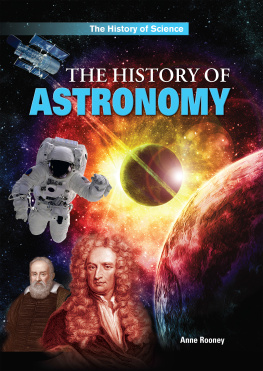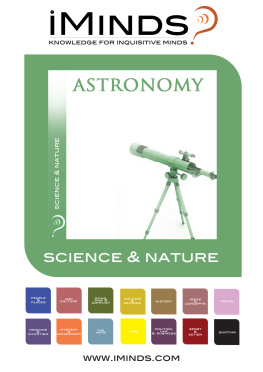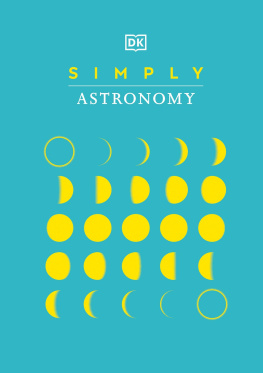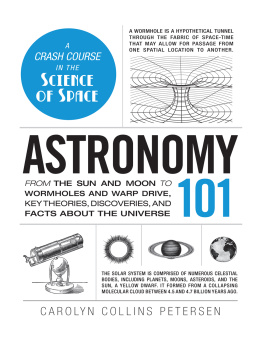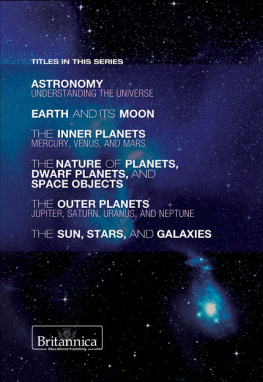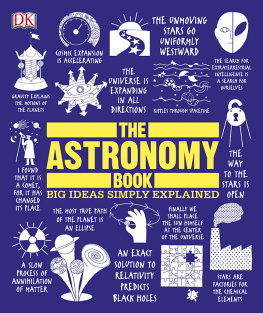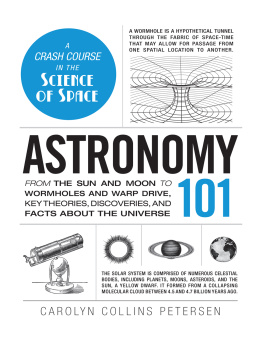FURTHER READING
Armitage, A., Edmond Halley (Nelson 1966)
Aughton, P., Newtons Apple (Weidenfeld & Nicolson 2002)
Aughton, P., Transit of Venus (Weidenfeld & Nicolson 2004)
Buttman, G., William Herschel (WVG Stuttgart 1961)
Comins, N.F. and Kaufmann, W.J., Discovering the Universe (W.H. Freeman 2005)
Donahue, W.H. Johannes Keplers New Astronomy (Cambridge University Press 1992)
Gribbin, J., In Search of the Big Bang (Heinemann 1986)
Hall, A.S., The Scientific Revolution 15001800 (Longman 1954)
Hawking, S., A Brief History of Time (Bantam 1988)
Hawking, S., The Universe in a Nutshell (Transworld 2001)
Hoffmann, B., Einstein (Paladin 1975)
Hogben, L., Science for the Citizen (George Allen 1938)
Longair, M.S., Our Evolving Universe (Cambridge University Press 1996)
Mitton, S., The Cambridge Encyclopaedia of Astronomy (Jonathan Cape 1977)
Moore, P., Watchers of the Stars (Michael Joseph 1974)
Roos, M., Introduction to Cosmology (Wiley 2003)
Sagan, C., Cosmos (Abacus 1980)
Skeat, W.W., Chaucer, the Complete Works (Oxford University Press 1912)
Weinberg, S., The First Three Minutes (Andr Deutsch 1977)
Westfall, R.S., Never at Rest (Cambridge University Press 1980)
White and Gribbin, Stephen Hawking, A Life in Science (Penguin 1992)
Wolf, A., A History of Science, Technology and Philosophy 2nd edn. (Allen Unwin 1950)
Wright, W.A. (ed.), The Rubaiyat of Omar Khayyam (Macmillan 1973)
INTRODUCTION
From the time of the very earliest civilizations people have wondered about the world they live in, about how it was created and about how it will end. Not the least they wanted to understand the mysterious world of the heavens above them. In this book we travel on a journey from those earliest peoples as they stared in fear and wonder at the night sky to the 21st century cosmologists as they peer into the deepest corners of space, often looking back in time.
Our journey follows an essentially chronological sequence. It pauses to look deeper at the significant discoveries and world of famous astronomers and scientists (such as Copernicus, Galileo, Newton and Hubble). The story is also punctuated by descriptions of significant advances in technology, such as that of the light telescope or space telescope, which have enabled astronomers to make huge leaps forward in their understanding of the universe. The role of the mathematicians and other theorists (from Aristarchus to Einstein and Hawking) are not forgottenat many stages in this story they have propelled our understanding of the cosmos to new levels.
In the most distant times the Sun was seen to make its daily journey across the sky, followed each night by the arrival of the Moon. The Moon was seen to wax or wane a little each time it appeared, and on a few nights it did not appear at all. Tiny specks of light dotted the great black dome of the heavens; some of these appeared in different nightly positions against their neighbors and became known as planets. It took millennia for man to determine the true nature of these wandering stars and to evolve a model of the world to accommodate them and to predict their positions in the sky.
It was thought that every star had its own purpose and that the secrets of the universe could be discovered by making a study of them. The telescope was invented and the hundreds of stars became thousands and then tens of thousands. There was the telescope of Galileo, followed by observatories at Paris and Greenwich, the telescopes of William Herschel and later the giant telescopes of Mount Wilson and Mount Palomar. At the end of the second millennium came the Hubble Space Telescope. The number of stars in the catalogs grew to hundreds of thousands and the number of stars visible in the telescopes became millions, and then billions. The number of stars in the sky became countless. How could these tiny points of light in the sky explain the beginnings of the world?
The tiny dots of light came under more and more scrutiny. Many of them were not simple dots at all, but whole galaxies, each consisting of millions or billions of stars. It was discovered that there was much more to light than first appeared. A star made an image on a photographic plate, but the light from the star could be spread out into its different wavelengths by passing it through a prism. The result was amazingnot only could astronomers discover the very elements the stars were made of but they could also work out the speed at which a star was approaching us or rushing away from us. There was more: some stars did not have a constant brightness and their distance could be calculated as they went through a cycle of variable brightness.
Then man discovered other wavelengths of radiation beyond the visible spectrum. The stars emitted not only visible light but also infrared, ultraviolet, radio frequencies, microwaves, gamma rays and X-raysmuch more was discovered about the stars by observing them in these wavelengths. The astronomer had to call on the physicist to explain many of his results; upon the mathematician to work out theories of gravitation and relativity; and upon the engineer to build more powerful telescopes, eventually sending his instruments into orbit to escape the filtering effects of the atmosphere.
Starlight provides all the information we need to put together the story of how we come to be here, on what may well prove to be a unique planet in the universe. We still do not know the answers to all of the questions, but we can now build on the observations of hundreds of generations of astronomers. At the start of the third millennium, we can put together a credible account of the story of the creation of the universe.
Peter Aughton
2008
1
THE ORIGINS OF ASTRONOMY
To the earliest peoples the heavenly bodies were a source of fear and wonder. The rising and setting Sun and the waxing and waning Moon seemed to be things controlled by the gods. In time, civilizations began to link celestial sights with earthly events, noting that they often coincided with fertile floods, harvests and other important features of everyday life. Later, they began to plot the positions of the stars and planets, and to give them names and meanings. So began the first studies in astronomy and astrology. By observing the heavens, the first calendars could also be made.
On the appointed day, in broad daylight, the whole community gathered outside the temple. There was a hush of reverence as the astronomer priests conducted a solemn ceremony before the frightened and apprehensive crowd. The astronomer priests had calculated that the Moon was rapidly approaching the Sun and that a once-in-a-lifetime event was about to happen. The wise refrained from looking at the Sun, but the foolish stared and saw that a small dark bite had been taken from the shining golden disc. At first the bite was trivial in size, but as it grew steadily it became a large, dark shadow blocking out the sunlight. Soon it was obvious even to those who lowered their eyes that the Sun had become weaker. Daylight was fading. There was a fear amongst the crowd that the Sun was under attack from an unknown and powerful enemy. Not even the village elders could remember an event like this before. What was this unknown force that was draining the strength of the Sun? What if the Sun were to be extinguished altogether and the world doomed to live in a state of perpetual darkness?
Now the Sun was covered completely. It became darknot totally black, but as if it were no longer daytime. There was a great hush as the community waited in fear. The birds had been chattering, but like the people present they, too, suddenly fell silent. Never had there been such a breathtaking silence when so many had been gathered together. Those who dared still gazed at the sky. They saw that the stars and planets, the familiar patterns of light in the night sky, had appeared in the middle of the day. These were sights that belonged with the night, not the daytime. It was a terrible omen from the gods. The total darkness lasted only a few minutes but it seemed much longer, and in the middle of the day it felt much stranger than any darkness they had known before.


